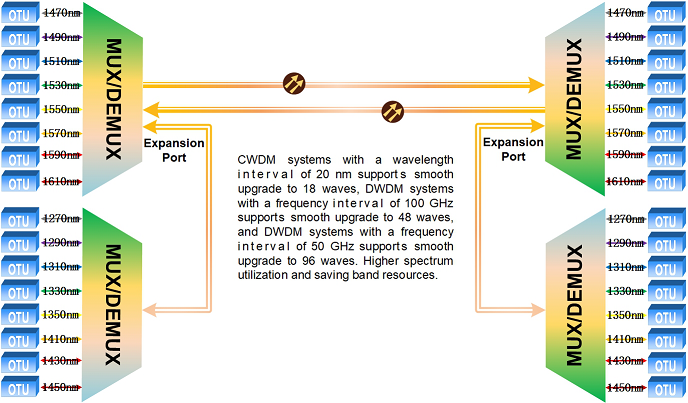
OSU Optical Splitter Unit
Product Overview
OSU optical splitter unit is a splitter based on planar optical waveguide technology introduced by Visint. It is mainly used for communication trunk, MAN, LAN, private network, DPI, FTTX of PON, etc. Our 1*N, 2*N planar waveguide optical splitters are small and cost effective. They support a wide wavelength range (1260-1620nm) and can provide customers with low insertion loss and low polarization dependent loss.
Inquiry Now
OSU optical splitter unit is a splitter based on planar optical waveguide technology introduced by Visint®. It is mainly used for communication trunk, MAN, LAN, private network, DPI, FTTX of PON, etc. Our 1*N, 2*N planar waveguide optical splitters are small and cost effective. They support a wide wavelength range (1260-1620nm) and can provide customers with low insertion loss and low polarization dependent loss.
Supporting single-mode and multi-mode, various network applications.
Supporting single window and multiple windows, optional splitting ratio.
Supporting PLC and FBT technology, low insertion loss, low polarization dependent loss.
Pure passive without power supply, non-power supply debugging, transparent transmission.
Supporting SNMP-based unified network management platform, network management mode CLI, WEB, NetRiver (graphical interface).
System Parameter | Technical Index | ||
Wavelength range | Single mode: 1260nm~1650nm, Multimode: 850nm. | ||
Insertion Loss | 1/2 | Single mode: 50%: ≤3.50dB, Multimode: 50%: ≤4.10dB. | |
1/3 | Single mode: 33.3%: ≤5.40dB, Multimode: 33.3%: ≤5.80dB. | ||
1/4 | Single mode: 25%: ≤7.00dB, Multimode: 25%: ≤7.60dB. | ||
1/8 | Single mode: 12.5%: ≤10.30dB, Multimode: 12.5%: ≤11.10dB. | ||
1/16 | Single mode: 6.25%: ≤13.50dB, Multimode: 6.25%: ≤14.20dB. | ||
1/32 | Single mode: 3.125%: ≤17.00dB, Multimode: 3.125%: ≤17.70dB. | ||
1/64 | Single mode: 1.563%: ≤20.50dB, Multimode: 1.563%: ≤21.20dB. | ||
60:40 | Single mode: 60%: ≤2.70 dB / 40%: ≤4.70dB, Multimode: 60%: ≤3.20 dB / 40%: ≤5.20dB. | ||
70:30 | Single mode: 70%: ≤1.90 dB / 30%: ≤6.00dB, Multimode: 70%: ≤2.50dB / 30%: ≤6.50dB. | ||
80:20 | Single mode: 80%: ≤1.20 dB / 20%: ≤7.90dB, Multimode: 80%: ≤1.40dB / 20%: ≤9.00dB. | ||
90:10 | Single mode: 90%: ≤0.80dB / 10%: ≤11.60dB, Multimode: 90%: ≤1.30 dB / 10%: ≤12.00dB. | ||
70:15:15 | Single mode: 70%: ≤1.90dB / 15%: ≤9.00dB, Multimode: 70%: ≤2.50dB / 15%: ≤10.50dB. | ||
80:10:10 | Single mode: 80%: ≤1.20dB / 10%: ≤11.60dB, Multimode: 80%: ≤1.20dB / 10%: ≤12.00dB. | ||
70:10:10:10 | Single mode: 70%: ≤1.90dB / 10%: ≤11.60dB, Multimode: 70%: ≤2.50dB / 10%: ≤12.00dB. | ||
60:20:10:10 | Single mode: 60%: ≤2.70dB / 20%: ≤7.90dB / 10%: ≤11.60dB, Multimode: 60%: ≤3.20dB / 20%: ≤9.00dB / 10%: ≤12.00dB. | ||
Polarization dependent loss(PDL) | ≤0.15dB. | ||
Return loss | ≥55dB. | ||
Directivity | ≥55dB. | ||
Network management mode | CLI , NetRiver, WEB. | ||
Product dimension | Single card: 177(W)*20(H)*225(D)(mm). Chassis unit: 482(W)*177(H)*250(D)(mm). | ||
Environmental requirements | Working temperature | -10℃ ~ 70℃. | |
Storage temperature | -40℃ ~ 80℃. | ||
Relative humidity | 5% ~ 95% no condensation. | ||
Safety and EMC | Compliance with FCC, UL, CE, TUV, CSA standards. | ||
Power consumption | <2W. | ||
Visint® Vispace 1000 series optical multiplexing and demultiplexing equipment is widely used to solve the problem of insufficient optical cable resources in transmission. Fabricated by thin film filter (TFF) technology and planar lightwave circuit (PLC) technology, multiple optical carrier signals are multiplexed onto a single-core optical fiber for transparent transmission, supporting dual-fiber bidirectional, single-fiber bidirectional, single-fiber single unidirectional and other types.
Application 1: Dual-fiber Bidirectional
The dual-fiber bidirectional multiplexes multiple optical carrier signals onto the two-core optical fiber for transmission, thereby realizing the use of the two-core optical fiber to transmit multiple services, thus greatly reducing the investment cost and saving the cable laying time.

Figure 1: Multiplexing/Demultiplexing Dual-fiber Bidirectional Application
The single-fiber unidirectional uses the optical reversible characteristic to multiplex multiple optical carrier signals onto a single-core optical fiber for transmission, thereby realizing multi-channel transmission by using one-core optical fiber, thus greatly reducing investment cost and saving cable laying time.

Figure 2: Multiplexing/Demultiplexing Single-fiber Bidirectional Application
The smooth upgrade is to access the splitter through the expansion port of the splitter in the original WDM system to achieve smooth upgrade and expansion without affecting the original service.

Figure 3: Multiplexing/Demultiplexing Smooth Upgrade Application